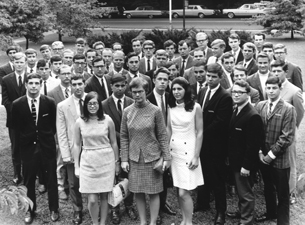 RSS
RSS
Fate to the Rescue
Between 1968, when the first students arrived, and 1975, when John Dempsey Hospital opened, students spent the majority of their academic time at the Farmington campusí Butler buildings, while most of the clinicians were at McCook Hospital. The administration decided something should be done to prepare for any emergencies among the students. As a temporary measure, Assistant Director of Nurses Irene Engel and Public Safety Department head Gregory Metcalf parked an old station wagon on campus, outfitted with various items, including emergency supplies packed in a fishing-tackle box. Then they requested a rescue truck from the motor pool. The request was denied. Several months later, Engel got a call from the motor pool telling her to come pick up the new vehicle. "Someone had inadvertently taken our request and placed the order," says Engel. "Thatís how we got our first rescue truck."
Watch the Video
Feature Story
Health Center Today, April 11, 2011
First Classes Admitted
By Noreen Kirk

First School of Medicine and Dental Medicine class (1972).
This story is the fourth of a multi-part series on the history of the Health Center. The entire series can be read at the Health Centerís 50th Anniversary website.
As construction projects often do, the massive one in Farmington, begun in 1966, took much longer than originally expected. The medical and dental schools were committed to admitting their first classes in the fall of 1968. By 1967, it was clear that the facility would not be ready. In a classic show of Yankee ingenuity, though, everyone involved found ways to make the undertaking work.
Temporary structures known as Butler buildings were erected at the base of the Farmington site to serve as classrooms. (These buildings are still in use today.) Some administrators and a small number of clinical faculty were housed at McCook. An auditorium in the Jones Home, a building adjacent to McCook, served as a lecture hall. The deansí offices and administration were housed in a downtown Hartford office building. The library assembled its collection in a building on Asylum Avenue, near Woodland Street. For laboratory work, students were bused to the Storrs campus, with faculty driving out in their own cars until temporary lab facilities were erected on Farmingtonís lower campus. The pharmacology laboratory was in an old building on the McCook campus until it began to collapse due to structural problems. Even by 1972, when Dr. Ravindra Nanda, joined the faculty of the dental school, conditions remained challenging. The Department of Orthodontics offices were in trailers behind McCook Hospital.
"On my first day, they showed me my room. There was a bucket in the middle of the floor," says Nanda, who now chairs the Department of Orthodontics. "It was raining outside, and rainwater was coming through the roof and dripping into the bucket."
The first classes were admitted as planned in 1968. They included 32 medical students and 16 dental students. These hardy young pioneers blazed the trails for generations of students to follow.
Dr. Scott Wetstone, now director of health affairs policy planning at the Health Center, first came to the medical school in the summer of 1974. To increase his chances of being accepted to the school in what was then a fiercely competitive environment, he took a time off from his studies at Wesleyan University to work for the school, writing computer-based educational programs while taking some medical school classes. He was later accepted, graduating in 1979.
"When I came in 1974, the academic building was open, but not the hospital," Wetstone says. "You could walk through a set of doors and be locked out of any habitable portion of the building. The cafeteria wasnít open. You had to go out to eat every day."
Students had Saturday classes. Each room in which classes met had 16 desks and workbenches. "The building was freezing cold. On Saturdays, it was so cold that when we arrived, weíd get out the large-head Bunsen burners so we could try to heat the room," Wetstone recalls.
Still, the education taking place was remarkable. One example of the caliber of instruction was Joseph "Jay" Healey, who joined the faculty in 1975 to teach social and behavioral sciences, was "one of the best teachers ever," says Wetstone. "He could take a class of 130 and make it feel as if you and he were the only ones in the room."
Healey routinely received outstanding ratings from students, even winning the prestigious Charles N. Loeser Award for excellence in teaching. Yet he was never satisfied. At one point, Wetstone was running a teaching assessment program. If student evaluations showed that "127 students loved him and three didnít, Jay would come to me and ask for ideas on how he could reach those three," Wetstone says. "He always wanted to get better. He was one of the legendary figures around here."

